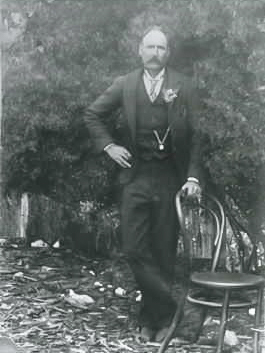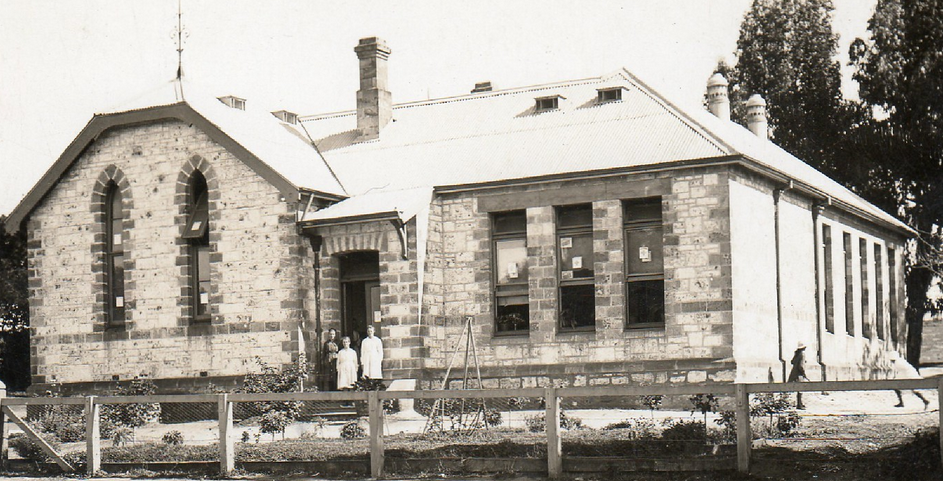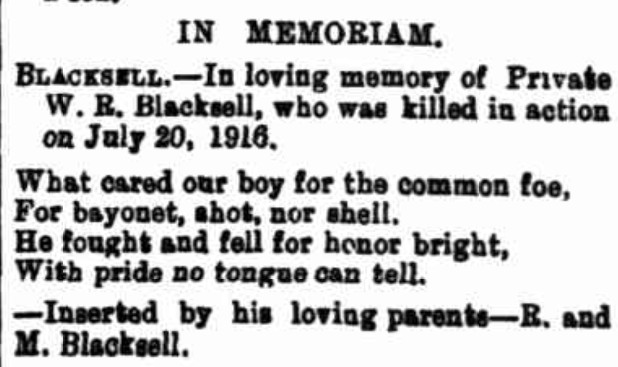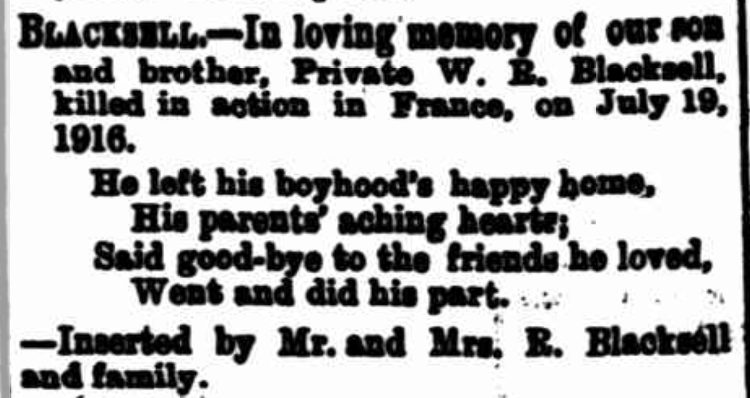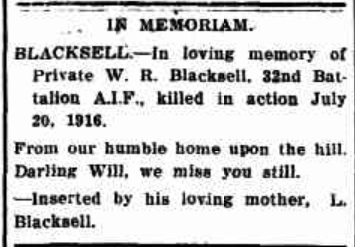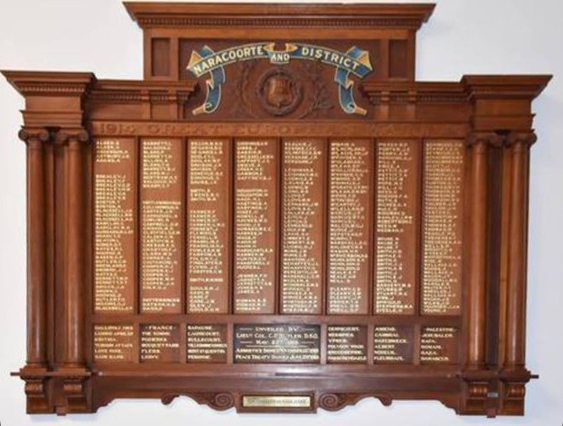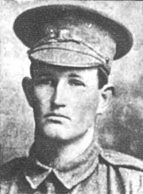
William Richard BLACKSELL
Eyes hazel, Hair dark brown, Complexion medium
William Richard Blacksell – He went and did his part
Can you help find Will?
William Richard Blacksell’s body was never found after the Battle of Fromelles, and there are no records of his burial.
A mass grave was found in 2008 at Fromelles, a grave the Germans dug for 250 Australian soldiers they recovered after the battle. As of 2024, 180 of these soldiers have been able to be identified via DNA testing.
Will may be among these remaining 70 unidentified men. There is still a chance to identify him — but we need help. We welcome all branches of his family to come forward to donate DNA to help with his identification, especially those with roots in Naracoorte, South Australia.
See the DNA box at the end of the story for what we do know about his family.
If you know anything of contacts for Walter, please contact the Fromelles Association.
Early Life
Born 29 September 1892 in Naracoorte, SA, Will, was the eighth of thirteen children of Richard Blacksell (1856-1931) and Mary Rubeena Jenkins (1857-1933), who were married at Benyeo, Victoria in 1877. In about 1890, they moved just across the border to Naracoorte, where Richard followed farming and labouring pursuits. Schooling for the children may have also been one of the needs. Seven of their children were born in Victoria and the rest in South Australia.
Will grew up in a large, close-knit family alongside his brothers and sisters:
- Margaret Mary (Maggie) Blacksell (1876–1958) – married Patrick McNamee
- Euphemia Blacksell (1878–1970) – married William Jarred
- Frances Clara (Tottie) Blacksell (1881–1971) – married Bert Fisk
- Alice Maud Blacksell (1883–1969) – married David Bowen
- Isabella Richardina (Bel) Blacksell (1886–1971) – married William Pill
- Charles John Richard Blacksell (1888–1968)
- Edith Jane Blacksell (1890–1960) – married William Charles
- William Richard Blacksell (1892–1916) – killed in action, Fromelles
- Richard George Blacksell (1894–1945)
- Hugh Frank Whilie Blacksell (1897–1959) – married Lillian Grierson
- Mary Ilean (Aileen) Blacksell (1899–1988) – married Tom Cameron
- Rubeaner “Ruby” Jessie Mary Blacksell (1901–2000) – married Thomas Cooper
- Percy Blacksell (1904–1992)
Will’s mother Mary was a daughter of John Jenkins, who at one time was the proprietor of the Criterion Hotel at Robe. Mary’s obituary noted her accomplished horsemanship - followed the hounds, took part as one of the beaters when coursing after wallabies on the Mosquito Plains and it also noted that in 1867 the Duke of Edinburgh presented her with a locket for her singing as a girl in Robe.
After his schooling, Will worked as a labourer and was active in the local community. In 1912, he was named among players of the Narracoorte Football Association for his involvement in regional sport.
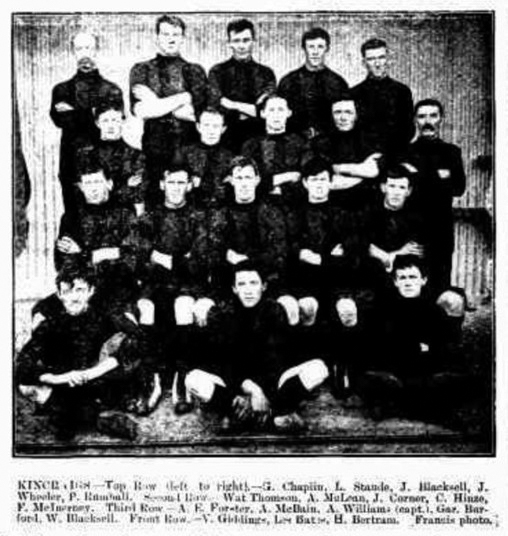
Naracoorte Football Association. (1912, November 22).
Will had a large extended family, a number of whom also served. His cousins Private James Archibald Blacksell (4986) and Sergeant James Munn (4248) lost their lives in the war.
Off to War
Will enlisted on 4 August 1915 in Adelaide, and was assigned to the 7th Reinforcements of the 27th Battalion. He was 20 years old, and like so many young men he was swept up by the call to serve. On 12 January 1916, he embarked from Adelaide aboard the HMAT Medic, bound for Egypt. After the Gallipoli campaign and with all the new recruits, the AIF was being reorganised.
In April, Will was transferred to the 32nd Battalion which had been formed in Australia in August. It was composed of two companies from South Australia and two from Western Australia. After Will arrived, they continuing their training and guarding the Suez Canal at Ferry Post until the end of May. Their last posting in Egypt was a few weeks at Moascar. In late June, the battalion sailed from Alexandria aboard the Transylvania and after a week at sea, they landed at Marseilles, France on 23 June 1916.
They were immediately entrained for the journey north. Their trip was in cramped cattle trucks marked “Hommes 40, Chevaux 8” — forty men or eight horses. Yet the mood was light-hearted, and the French civilians turned out in force.
One man wrote:
“The people stood along the line cheering, throwing us fruit, cigarettes and bottles of wine. We felt like heroes already, though none of us had yet fired a shot in France.”
They were headed to the area of Fleurbaix in northern France which was known as the ‘Nursery Sector’ – a supposedly relatively quiet area where inexperienced Allied troops could learn the harsh realities of Western Front trench warfare against the Germans. But the quiet times did not last long. Training continued with a focus on bayonets and the use of gas masks, assuredly with a greater emphasis given their position near the front.
The 32nd moved to the Front on 14 July and Will was into the trenches for the first time on 16 July, only three weeks after arriving in France.
The Battle of Fromelles
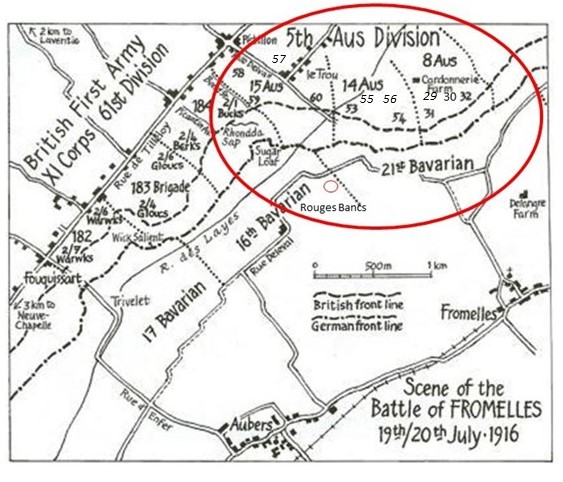
On the 17th, the 32nd were reconnoitering the trenches and cutting passages through the barbed wire, preparing for an attack, but it was delayed due to the weather. D Company’s Lieutenant Sam Mills’ letter home was optimistic for the coming battle:
“We are not doing much work now, just enough to keep us fit—mostly route marching and helmet drill. We have our gas helmets and steel helmets, so we are prepared for anything. They are both very good, so a man is pretty safe.”
The overall plan was to use brigades from the Australian Fifth Division to conduct a diversionary assault on the German trenches at Fromelles. The 32nd Battalion’s position was on the extreme left flank, with only 100 metres of No Man’s Land to get the German trenches. As they advanced, they were to link up with the 31st Battalion on their right. However, their position made the job more difficult, as not only did they have to protect themselves while advancing, but they also had to block off the Germans on their left, to stop them from coming around behind them.
On the morning of the 18th, A Company and C Company went into the trenches to relieve B and D Companies, who rejoined the next day. The Zero Hour for advancing from their front-line trenches was to be 5.45 PM, but the Germans knew this attack was coming and were well-prepared. They opened a massive artillery bombardment on the Australians at 5.15 PM, causing chaos and many casualties. The charge over the parapet began at 5.53 PM. Will’s A Company and C Company were in the first and second waves to go, B & D were in the third and fourth.
They were successful in the initial assaults and by 6.30 PM were in control of the German’s 1st line system (map Trench B), which was described as “practically a ditch with from 1 to 2 feet of mud and slush at the bottom”.
Source: AWM4 23/49/12, 32nd Battalion War Diaries, July 1916, page 11
Unfortunately, with the success of their attack, ‘friendly’ artillery fire caused a large number of casualties because the artillery observers were unable to confirm the position of the Australian gains. They were able to take out a German machine gun in their early advances, but were being “seriously enfiladed” from their left flank.
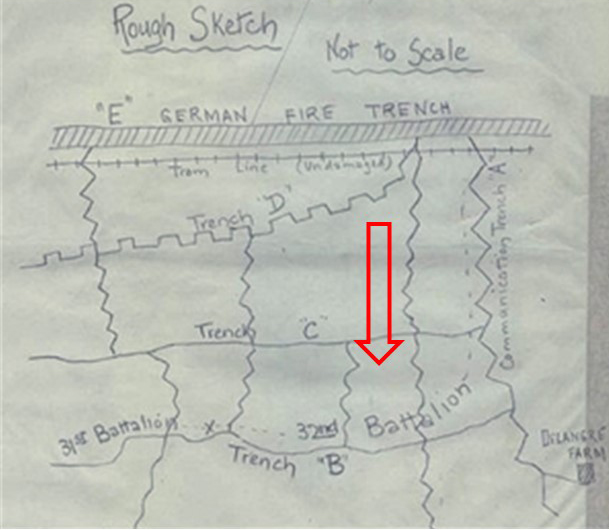
By 8.30 PM their left flank had come under heavy bombardment with high explosives and shrapnel. Return bombardment support was provided and the 32nd were told that “the trenches were to be held at all costs”.
Source: AWM4 23/49/12, 32nd Battalion War Diaries, July 1916, page 12
Fighting continued through the night. The Australians made a further charge at the main German line beyond Trench B, but they were low on grenades, there was machine gun fire from behind them from the emplacement at Delangre Farm and they were so far advanced that they were getting shelled by both sides. In the early morning of the 20th, the Germans began a counterattack from the Australian’s left flank, bombing and advancing into Trench A (map).
Given the Australian advances that had been made earlier, the rear Trench E had been left almost empty, which then enabled the Germans to regain that trench and envelop the men of the 32nd. At 5.30 AM the Germans attacked from both flanks in force and with bombing parties. Having only a few grenades left, the only resistance they could offer was with rifles:
“The enemy swarmed in and the retirement across No Mans’ Land resembled shambles, the enemy artillery and machine guns doing deadly damage.”
What was left of the 32nd had finally withdrawn by 7.30 AM on the 20th. The initial roll call count was devastating – 71 killed, 375 wounded and 219 missing, including Will. To get some perspective of the battle, when Charles Bean, Australia’s official war historian, attended the battlefield two and half years later, he observed a large quantity of bones, torn uniforms and Australian kit still on the battlefield.
The final impact was that 228 soldiers of the 32nd Battalion were killed or died from wounds sustained at the battle and, of this, 166 were unidentified.
Lieutenant Sam Mills survived the battle. In his letters home, he recalls the bravery of the men:
“They came over the parapet like racehorses……… However, a man could ask nothing better, if he had to go, than to go in a charge like that, and they certainly did their job like heroes."
After the Battle
Will was among the missing and the family were notified, but no hard information was available from formal channels for an anxious family. In September, the family did get a ‘hopeful’ letter via the family of one of Will’s mates, Private Malcolm A. Stephens (3327), 29th Battalion, who was from the nearby town of Apsley. He had written that he said he had seen Will wounded and being carried back by stretcher bearers.

Nothing formal followed and in January 1917, Will’s sister Bel wrote a heartbreaking letter to Base Records, desperate for news and any word of his fate:
Murray Bridge, South AustraliaJan 24th, 1917
To the Australian Red Cross Commissioner,
Please I am writing a few lines just to ask you please if you can give me any trace of my brother, Private W. R. Blacksell, A Company, 32 Battalion, 8th Brigade, who has been reported missing since the 20th of July 1916. Please can’t you tell me any way in which I might be able to find my dear brother, he is all the world to me and it is driving me out of my mind, as I can’t get a trace of him.
One of his mates wrote home and told us that he saw my brother on a stretcher wounded, and now in another letter that my brother had died from his wounds. I have done all I can but can’t find out anything. If he is a prisoner of war how can I find out? Please kindly tell me, hoping you will be able to help me in this matter.
I will close with all my good wishes and may God be with all our boys at the front.
Yours faithfully,Mrs. W. PillMurray Bridge
The next news was not until a Red Cross witness statement taken in February 1917 from Corporal Morgan Brown (53) who stated that he was told that Will had been struck and killed by a shell in the initial charge:
“After the fight at Fromelles on the date mentioned I was told by my chum Corporal Atkinson… that he Blacksell and (200 Leonard George) Wall were all charging together when a shell burst and killed Blacksell and Wall instantly without touching himself, and that he had had a wonderful escape. This happened within a few yards of our trench, just after they had gone over the parapet.”
This report was apparently not provided to the family as they continued to write for months as they clung to hope. There is a letter a year after the battle still seeing what happened to Will:
it is now nearly 12 months and no trace have we got.
It wasn’t until a 12 August 1917 Court of Enquiry in the field declared that Will was confirmed as having been killed in action. Despite Corporal Stephens’ recollection, Will’s body was never recovered from the battlefield at Fromelles.
Remembering Will
Will’s death was felt not just by his family, but also the community. The Naracoorte Herald of 1 September 1916 expressed the community’s grief:
“The friends of Mr and Mrs R. Blacksell, of Naracoorte, will learn with deep regret of the death of their son, Private William Blacksell, who has been killed in action in France… He was only 23 years of age, and was well known and respected throughout the district.”
His family placed loving tributes in South Australian newspapers for years after the war.
Will is commemorated at:
- Adelaide Commissioner of Public Works Roll of Honour,
- Adelaide National War Memorial,
- Australian War Memorial Roll of Honour, Frances War Memorial,
- Naracoorte War Memorial,
- Naracoorte and District Town Hall Honour Board WW1,
- V.C. Corner Australian Cemetery Memorial
Family at War
The Great War was cruel to the wider Blacksell and Munn families, who suffered multiple losses across cousins and kin:
- Private John Mark Munn of Hynam, South Australia, enlisted in March 1916 with the 27th Battalion. A former Hynam Public School boy and labourer, he was killed in action at Mont St Quentin on 2 September 1918, aged 23. He has no known grave and is commemorated at the Villers-Bretonneux Memorial, as well as at Naracoorte and Adelaide.
- Sergeant Thornton Douglas Gordon Munn, born at Apsley, Victoria, in 1895, enlisted in 1915 with the 59th Battalion. A grazier by trade, he survived the war and returned home, later passing away at Edenhope, Victoria, in 1976. His name is honoured on the Apsley War Memorial and Kowree Shire Honour Roll.
- Private James Archibald Blacksell, born at Edenhope in 1879 and raised at Naracoorte, enlisted with the 43rd Battalion. A labourer, he was wounded in France and died on 5 August 1917. He is buried at Boulogne Eastern Cemetery, France, and commemorated at Adelaide, the AWM, and Naracoorte.
Finding Will
Will Blacksell’s remains were not recovered, he has no known grave. After the battle, the Germans recovered 250 Australian soldiers and placed them in a burial pit at Pheasant Wood. This grave was discovered in 2008 and since then efforts have been underway to identify these soldiers by DNA testing from family members. As of 2024, 180 of the soldiers have been identified, including 41 of the 166 unidentified soldiers from the 32nd Battalion.
We welcome all branches of Will’s family to come forward to donate DNA to help with his identification. We hope that one day Will will be named and honoured with a known grave.
Please visit Fromelles.info to follow the ongoing identification project and Will’s story.
DNA samples are being sought for family connections to
| Soldier | William Richard Blacksell (1892–1916) b Naracoorte, SA; died Fromelles |
| Parents | Richard Blacksell (1856–1931), b. Tatiara, Robe, SA – d. Naracoorte, SA, and Mary Rubeena Jenkins (1857–1933), b. Benayeo, Vic. – d. Naracoorte, SA |
| Siblings | Margaret Mary (Maggie) Blacksell (1876–1958) – married Patrick McNamee | ||
| Euphemia Blacksell (1878–1970) – married William Jarred | |||
| Frances Clara (Tottie) Blacksell (1881–1971) – married Bert Fisk | |||
| Alice Maud Blacksell (1883–1969) – married David Bowen | |||
| Isabella Richardina (Bel) Blacksell (1886–1971) – married William Pill | |||
| Charles John Richard Blacksell (1888–1968) | |||
| Edith Jane Blacksell (1890–1960) – married William Charles | |||
| William Richard Blacksell (1892–1916) – killed in action, Fromelles | |||
| Richard George Blacksell (1894–1945) | |||
| Hugh Frank Whilie Blacksell (1897–1959) – married Lillian Grierson | |||
| Mary Ilean (Aileen) Blacksell (1899–1988) – married Tom Cameron | |||
| Rubeaner “Ruby” Jessie Mary Blacksell (1901–2000) – married Thomas Cooper | |||
| Percy Blacksell (1904–1992) |
| Grandparents | |||
| Paternal | Charles Blacksell (1814–1893), b. Sydney, NSW – d. Hynam, SA, and Elizabeth Jane Anne Muirhead (1835–1919), b. Musselburgh, Midlothian, Scotland – d. Tatiara, SA | ||
| Maternal | John Jenkins (c.1819–1893), b. Skye, Scotland – d. Naracoorte, SA, and Euphemia McNeil (c.1829–1875), b. Skye, Scotland – d. Benayeo, Vic. |
Note - early pioneers of South Australia (According to SA deaths, Charles’s father, Richard Blacksall, died 30 March 1865 at Mount Gambier, reportedly aged 101.
Links to Official Records
Seeking DNA Donors

Contacts
(Contact: carla@fromelles.info or geoffrey@fromelles.info).
(Contact: army.uwc@defence.gov.au or phone 1800 019 090).
Donations
If you are able, please contribute to the upkeep of this resource.
(Contact: bill@fromelles.info ).
